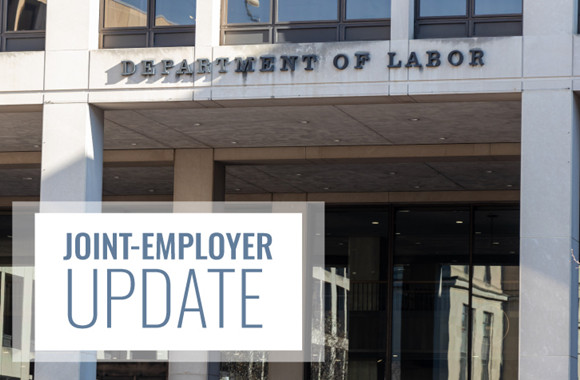✕



✕

Tag:joint-employer status 2020-01-19 17:35
REPORT FROM THE U.S.—While there is still some room for interpretation by courts, the U.S. Department of Labor’s new rule on joint-employer status comes as welcome news to the hotel industry.

Photo: JL IMAGES / Shutterstock.com; illustration: Rachel Daub
The labor department’s Wage and Hour Division announced earlier this week its final rule to update the joint-employer status under the Fair Labor Standards Act, setting up a four-factor test to determine whether an employee has more than one employer. The Labor Department announced the proposed changes to this rule in April 2019.
The test looks at whether a potential joint employer can:
1.hire or fire an employee;
2.supervise or control an employee’s schedule or conditions of employment to a substantial degree;
3.determine an employee’s rate and method of payment; and
4.maintain an employee’s employment records.
The rule also states that “additional factors may be considered, but only if they are (indicators) of whether the potential joint employer exercises significant control over the terms and conditions of the employee’s work.”
The rule will become effective in early March.
Industry response
The Asian American Hotel Owners Association welcomed the news of the updated rule. In a statement, AAHOA said previous rulings slowed business development and new hiring because uncertain standards could have resulted in a franchisor potentially assuming responsibility for a franchisee’s employees. The test set up by the new rule clarifies the obligations in the franchisor/franchisee agreement as well as offering increased certainty for franchisees about ownership and control of their businesses.
“America’s hoteliers applaud the DOL’s ruling, for it provides franchise owners with a clear and straightforward joint employer standard,” AAHOA President and CEO Cecil Staton said in the statement. “Over 80% of AAHOA members own franchised properties. The franchise business model continues to serve as an on-ramp to economic empowerment for America’s entrepreneurs. Returning to the traditional joint-employer standard gives owners the peace of mind that they will remain in control of their businesses.”
What does it mean?
The rule update is a positive development for employers, said Andria Ryan, partner at Fisher Phillips. The previous rule meant that if two entities were not acting entirely independently of each other, there was a good chance both could be considered joint employers. There were also a few judicial decisions that were different from each other that applied to their specific circuits, she said. The previous interpretation of the test was 60 years old and didn’t contemplate the realities of today’s workforce.
The new rule is going to be particularly helpful to the hotel and restaurant industries, Ryan said.
For example, if a hotel company hired a housekeeper from a staffing agency, under the old rule, that hotel company could have potentially been considered a joint employer. That means if the housekeeper from the agency worked a few days at one hotel company and then more days at another company, and if the employee worked more than 40 hours during the week, then the hotel company, not just the staffing agency, could have been responsible for covering some of the overtime cost, she said.
The justification would have been the hotel company would have required the housekeeper from the staffing agency to wear a uniform and name tag with the hotel’s name on it, she said. It also could have been requiring the housekeeper to read the sexual harassment policy and to agree to follow it.
“The more steps you take toward control of those employees, the closer you are getting on to be a joint employer,” she said about the old rule.
Another situation could be the store-within-a-store situation, such as having a Starbucks coffee shop in a hotel lobby, Ryan said. While the coffee shop is through a different operator, the coffee shop employees are still working in the hotel.
The Labor Department’s new rule means situations like those examples will not be factors for the purpose of determining joint-employer status, Ryan said.
“The existence of a franchise or franchisee relationship in and of itself is not going to make a joint-employer status more likely,” she said.
Under this rule, franchisors and hotel owners can set some standards without having to worry about becoming a joint employer with franchisees and third-party management companies, Ryan said.
“The department of labor’s given us a little bit of room here,” she said. “They’re saying, ‘OK, you can have some standards in that area as well—what you do with your other areas like operations and branding—you can have some standards, as long as you’re not exerting significant control over employees’ day-to-day work life.”
The “significant control” portion is a catch-all provision that the courts will have more leeway with, Ryan said. That’s something the hotel industry will have to keep its eye on to see how the circuit and federal courts handle it. Even with that, the Labor Department’s new rule is a positive development for the industry, she said.
Source:website-hotelnewsnow
Author:Bryan Wroten
About Us Terms of Service Privacy Policy Contact Us
Hotline(+86)17301604571
 Enterprise WeChat
Enterprise WeChat
for Client Service
 EZBuy
EZBuy
WeChat APP
Sinoexpo Digital Platform
Shanghai Sinoexpo Informa Markets International Exhibition Co., Ltd. All rights reserved
沪ICP备05034851号-77
 沪公网安备31010402000543号
沪公网安备31010402000543号